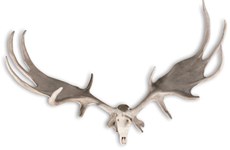
The buyer at Dominic Winter of South Cerney on October 8 was a French taxidermy collector.
Prized for centuries for its soft down, the great auk was subject to some of the first conservation laws but was finally driven to extinction by the European museums and collectors who paid handsomely to own skins and eggs for display. The last confirmed birds were killed on Eldey, a stone stack off the coast of Iceland, on June 3, 1844, on request from a merchant.
Following the bird’s sad demise, prices for its remains rose again: eggs and skins were sold at auction for enormous prices in the Victorian era.
In the 1920s, to meet demand for specimens, the famous taxidermists Rowland Ward of Piccadilly started producing well-made replicas using the feathers of the razorbill (the auk’s closest living relative). The distinctive bulbous black beaks with grooves on its surface were made from scratch.
This specimen measured just over 2ft (60cm) high – a little smaller than a fully grown adult bird that stood around 2ft 8in (80cm) high. It was made for Captain Vivian Hewitt (1888-1965), an aviator, ornithologist and conservationist.
The lot was sold with a copy of the original invoice dated February 22, 1922, reading: To supplying 1 Great Auk egg, hand painted, and mounting with replica of Great Auk bird in an all glass case with natural groundwork and surroundings £10 10s plus packing at a further 12s 6d.
More recently it was part of the natural history collection assembled by the late David Wilson and was pictured in Errol Fuller’s 1999 book The Great Auk.
Despite some damage to the beak and a crude tape-reinforcement to the frame of the case, it generated huge interest at its £500-800 estimate. Online bidders took it beyond £10,000 before two of 10 phones exchanged the final blows. With 20% premium, the price was over £30,000.
There are an estimated 80 specimens of the great auk preserved in museums around the world (15 in the UK). The last offered at auction was bought in 1971 by the Icelandic Museum of National History for £9000.














